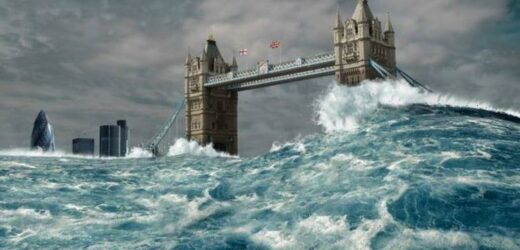Tsunami: National Geographic explain process
We use your sign-up to provide content in ways you’ve consented to and to improve our understanding of you. This may include adverts from us and 3rd parties based on our understanding. You can unsubscribe at any time. More info
A tsunami is a series of vast waves in a water body, generally an ocean or large lake, caused by the displacement of a large volume of water. They generally consist of a number of waves as they arrive in a so-called “wave train”. They can be several metres high, and can cause devastating destruction.
Among the deadliest natural disasters in history was the 2004 Indian Ocean tsunami, which left at least 230,000 people killed or missing in 14 countries.
This tsunami was caused by a 9.3 magnitude earthquake off the western coast of Sumatra.
However, earthquakes are not the only things that can cause tsunamis.
The three Storegga Slides are some of the largest known submarine landslides in history.


They occurred at the edge of Norway’s continental shelf, and involved a collapse of an estimated 290km (180mi) of coastal shelf, amassing 3,500km³ (840 cubic miles) of debris.
The resultant tsunami saw a 20-metre-high tsunami towering towards the Shetland Islands, off the coast of Scotland.
Researchers at the universities of Sheffield, St Andrews and York found this year that around 600km (370mi) of Scotland’s northern and eastern coastline were affected, and water reached as far as 29km (18mi) inland.
Their work, published in a research paper in Wiley’s Online Library, used luminescence to date the sediment deposits of the site of Maryton in Aberdeenshire.

The wave of destruction struck over 8,000 years ago, and is considered the largest natural disaster to hit the UK in the last 11,000 years. The displaced water is believed to have hit Doggerland, the land bridge that linked Britain to mainland Europe, and would have had a devastating impact on the Mesolithic populations of the time.
However, researchers at the University of Dundee in Scotland found evidence of two additional tsunamis, each at least 12m (40ft) high, thousands of years after the Storegga Slide.
Dr Sue Dawson from the University of Dundee told the university’s website in 2018, as part of the Landslide-Tsunami project: “We found sands aged 5,000 and 1,500 years old at multiple locations in Shetland, up to 13m above sea level. These deposits have a similar sediment character as the Storegga event and can therefore be linked to tsunami inundation.”
The discovery triples the number of known tsunamis recorded in the UK in the last 10,000 years.
DON’T MISS:
Archaeologists stunned by ‘unusual material’ found in Babylon [INSIGHT]
La Palma landslide ‘could kill millions of people’ [REPORT]
German supertrawler put to shame after horrifying footage [INSIGHT]

Professor David Tappin of the British Geological Survey told the BBC at the time: “They’re much higher frequency, and 1,500 years ago is very, very recent — it’s 500 AD if you want to think about it like that.
“It means that the hazard — the risk — is far more serious than we thought previously. And so what we’re trying to do now is better define it.”
Prof Tappin’s team will use the data from the deposits to create 3D simulations of the tsunamis, and work backwards to pinpoint their sources.
Making sense of the clues, however, could take decades.

Prof Tappin added submarine landslides are “much more poorly understood” than other natural hazards.
He said: “They can be far larger than any landslide seen on land ‒ the Storegga Slide contained 300 times the amount of sediment carried each year by all of the world’s rivers combined.
“Submarine landslides can also occur on slopes of just one of two degrees, and we still don’t know exactly how they are set in motion, except that earthquakes are considered to be the most common trigger.
“It is critical that we learn more.”
His findings suggest these landslides can occur anywhere in the ocean, and do not require a steeply inclined seabed.
Further research and analysis of the sediment deposits this year from the aforementioned universities has come to a slightly different conclusion, however.
Mark Bateman, professor of geography at the University of Sheffield, told the university’s website: “Although the Storegga tsunami has been known about for years, this is the first time we have been able to model how far inland from Scotland’s coastline the tsunami wave travelled, by analysing the soil deposits left by the wave over 8,000 years ago.
“Though there is no similar threat from Norway today, the UK could still be at risk from flooding events from potential volcanic eruptions around the world, such as those predicted in the Canary Islands.
“These would cause a similar resulting tsunami wave due to the amount of material that would be displaced by the volcano. These models give us a unique window into the past to see how the country was, and could again be, affected.”
Source: Read Full Article


